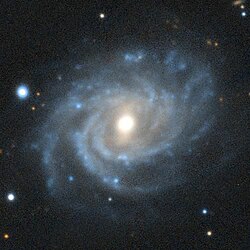
NGC 7038 is an intermediate spiral galaxy located about 210 million light-years away in the constellation of Indus. Astronomer John Herschel discovered NGC 7038 on September 30, 1834.

NGC 4753 is a lenticular galaxy located about 60 million light-years away in the constellation of Virgo. NGC 4753 was discovered by astronomer William Herschel on February 22, 1784. It is notable for having distinct dust lanes that surround its nucleus. It is a member of the NGC 4753 Group of galaxies, which is a member of the Virgo II Groups, a series of galaxies and galaxy clusters strung out from the southern edge of the Virgo Supercluster.

NGC 4564 is an elliptical galaxy located about 57 million light-years away in the constellation Virgo. NGC 4564 was discovered by astronomer William Herschel on March 15, 1784. The galaxy is also a member of the Virgo Cluster.
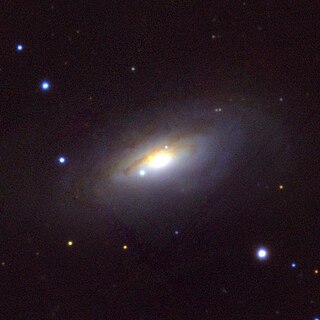
NGC 3285 is a barred spiral galaxy located about 200 million light-years away in the constellation Hydra. The galaxy was discovered by astronomer John Herschel on March 24, 1835. NGC 3285 is a member of the Hydra Cluster.

NGC 3305 is an elliptical galaxy located about 190 million light-years away in the constellation Hydra. The galaxy was discovered by astronomer John Herschel on March 24, 1835. NGC 3305 is a member of the Hydra Cluster.

NGC 3307 is a lenticular galaxy located about 185 million light-years away in the constellation Hydra. The galaxy was discovered by astronomer John Herschel on March 22, 1836 and is a member of the Hydra Cluster.
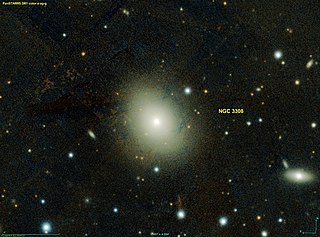
NGC 3308 is a lenticular galaxy with a faint bar located about 174 million light-years away in the constellation Hydra. NGC 3308 was discovered by astronomer John Herschel on March 24, 1835. It is a member of the Hydra Cluster.
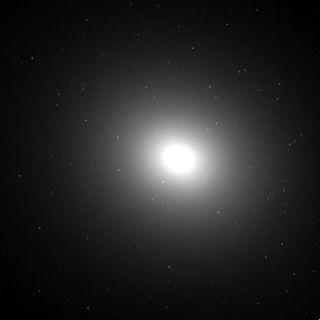
NGC 3309 is a giant elliptical galaxy located about 200 million light-years away in the constellation Hydra. NGC 3309 was discovered by astronomer John Herschel on March 24, 1835. The galaxy forms a pair with NGC 3311 which lies about 72,000 ly (22 kpc) away. Both galaxies dominate the center of the Hydra Cluster.

NGC 3311 is a supergiant elliptical galaxy located about 190 million light-years away in the constellation Hydra. The galaxy was discovered by astronomer John Herschel on March 30, 1835. NGC 3311 is the brightest member of the Hydra Cluster and forms a pair with NGC 3309 which along with NGC 3311, dominate the central region of the Hydra Cluster.

NGC 3312 is a large and highly inclined spiral galaxy located about 194 million light-years away in the constellation Hydra. The galaxy was discovered by astronomer John Herschel on March 26, 1835. It was later rediscovered by astronomer Guillaume Bigourdan on February 26, 1887. NGC 3312 was later listed and equated with IC 629 because the two objects share essentially the same celestial coordinates. NGC 3312 is the largest spiral galaxy in the Hydra Cluster and is also classified as a LINER galaxy.

NGC 3313 is a large barred spiral galaxy located about 55 megaparsecs away in the constellation Hydra. It was discovered by astronomer Ormond Stone in 1886 and is an outlying member of the Hydra Cluster.

NGC 3315 is a lenticular galaxy located about 185 million light-years away in the constellation Hydra. It was discovered by astronomer Edward Austin on March 24, 1870. It is a member of the Hydra Cluster.
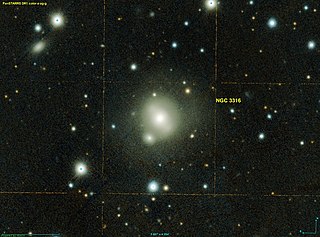
NGC 3316 is a barred lenticular galaxy located about 190 million light-years away in the constellation Hydra. The galaxy was discovered by astronomer John Herschel on March 26, 1835. NGC 3316 is a member of the Hydra Cluster, and appears to have a small companion galaxy known as HCC 15.

NGC 3369 is a lenticular galaxy located about 175 million light-years away in the constellation Hydra. NGC 3369 was discovered by astronomer Ormond Stone in 1886 and is an outlying member of the Hydra Cluster.
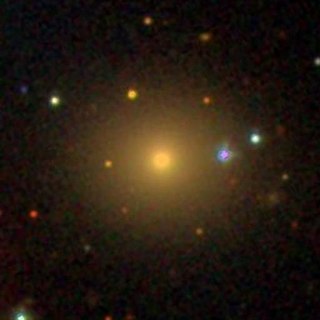
NGC 1259 is a lenticular galaxy located about 243 million light-years away in the constellation Perseus. The galaxy was discovered by astronomer Guillaume Bigourdan on October 21, 1884 and is a member of the Perseus Cluster.

NGC 1268 is a spiral galaxy located about 140 million light-years away in the constellation Perseus. It was discovered by astronomer Heinrich d'Arrest on February 14, 1863. NGC 1268 is a member of the Perseus Cluster and appears to show signs of distortion in the form of bridges. These features may be the result of a strong interaction with NGC 1267.
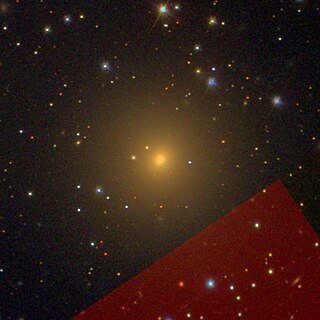
NGC 1272 is a massive elliptical galaxy located about 230 million light-years away in the constellation Perseus. It was discovered by astronomer Heinrich d'Arrest on February 14, 1863. NGC 1272 has an active nucleus and is the second brightest member of the Perseus Cluster after NGC 1275.

NGC 1282 is an elliptical galaxy located about 230 million light-years away in the constellation Perseus. It was discovered by astronomer Guillaume Bigourdan on October 23, 1884. NGC 1282 is a member of the Perseus Cluster.
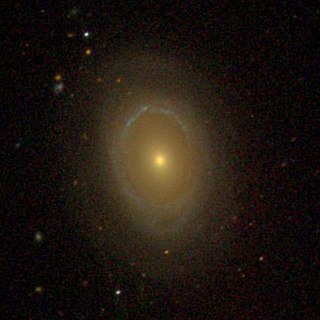
NGC 3884 is a spiral galaxy located about 330 million light-years away in the constellation Leo. The galaxy was discovered by astronomer William Herschel on April 27, 1785 and is a member of the Leo Cluster.

NGC 4307 is an edge-on spiral galaxy located about 65 million light-years away in the constellation Virgo. It was discovered by astronomer Christian Peters in 1881 and is a member of the Virgo Cluster. It is also a LINER galaxy.
